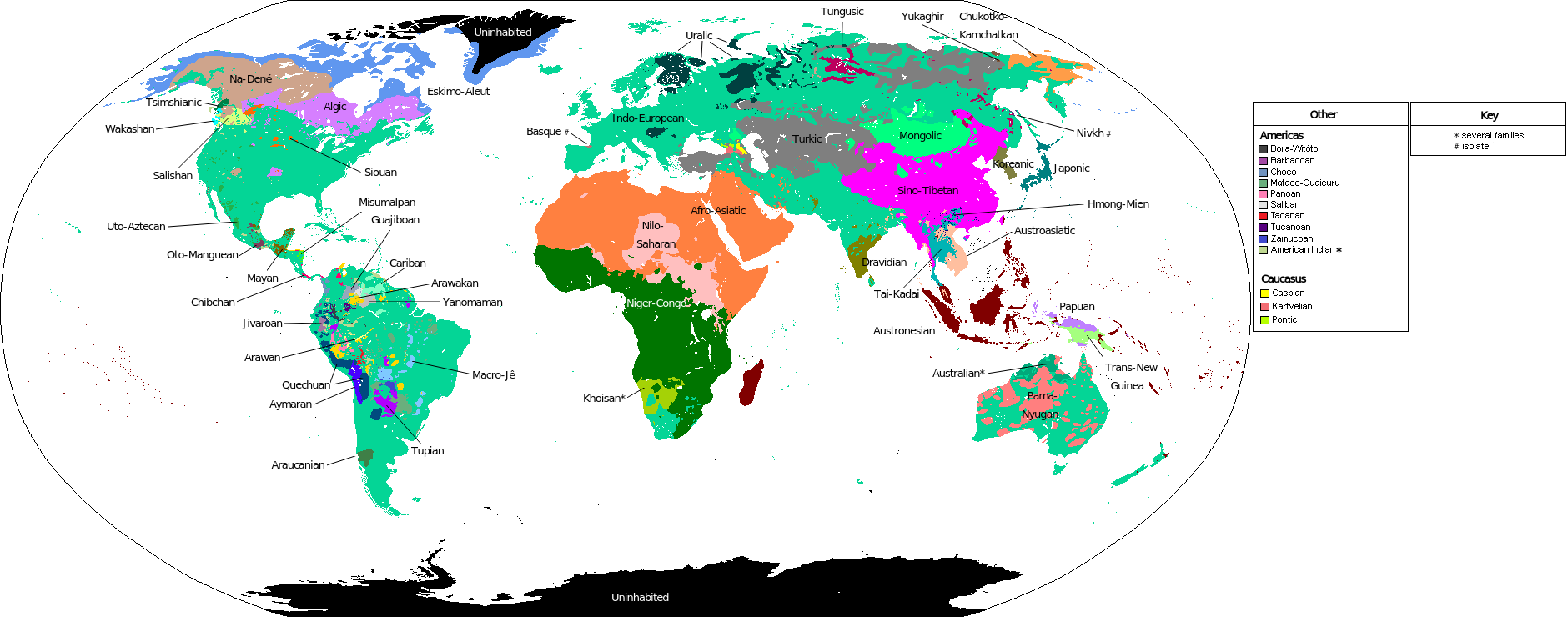




 |  |  |  |  |
 |  |  |  |  |  |  |
Population growth of a powerful part of the population is often an indication of an increase of the language of that group. In historic times this was often related for male paternal lines. Discrete population growth of a significant percentage of the population can indicate the change of a language in a certain region in a certain timeperiod. Continuous population is unlikely to have strong impact on language changes.
Some reports on the major relations between languages and Y-DNA can be found on:
Island pattern: when populations were small they stayed on their location for a long period. This gives an "island-pattern". This results in long narrow Y-DNA branches, an isolated language, and a limited amount of violence between tribes. Exchange of ideas, knowledge, DNA was very limited. This pattern is present in the Americas, New Guinea, Andaman Islands, Khoisan languages, Ainu (in Japan), Negrito languages in Phillipines etc.
Tribal pattern: knowledge increased, population grows, diversity of roles in the community and an additional pressure on the powerfull people to conquer land from other peoples, so the own tribe can expand. This results often in a population jump, a migration and development of a language family. This is the case for Indo-Europeans (5000ybp), Bantu (4000ubp), Austronesian (4000ybp), Japonic (3000ybp), Korean (3000ybp). In later periods one can see characteristics in Berber, Arab, Finnic, Slavic.
Power increased with language distribution with limited Y-DNA characteristics. This is the case with the Hungarian language. Sino-Tibetan, Roman languages.
I don't knowI found insufficient data to make conclusions on these language families: Tai-Kadai, Austroasiatic.
Individual migrations: these happened in recent times when people migrated individually or in small groups without options to trace an individual line based on group migrations. These typically happened with people looking for a better chance to survive from Europe and other areas to the Americas, South-Africa, Australia, New-Zealand or as slave migrations. In these situations the language was chosen by the early arriving people (e.g. English, Spanish, Portuguese).
A review on the general concept of language change is given on the NativLang channel of youtube. An interesting article on the automated age determination of the languages is reported by Holman et al. (2011; doi:10.1086/662127)
Contact is a clear example of language change. Pidgin, Creolo are examples of mixing styles of languages. This is determined by the level of isolation. In case of contact it is expected that a less powerfull group adjusts his language on the aspects that is relevant for them. The Anglo-saxons in Britain maintained the Anglo-saxon words for the animals when producing meat in the 13th-15th century, but when it was presented as a dish to the French elite, they used the Anglo-French words.
The time estimates of Y-DNA are based on good statistics and fairly good normalization. The age determination from glottochronology gives a good general pattern, but the accuracy of the estimates is very limited. No good normalization exists, changes in small groups and in large groups are different, and cultural organization and mixtures also contribute to the speed of language change. A difference of 30 percent between a fairly accurate age estimate in Y-DNA and an inaccurate age estimate from glottochronology is no surprise.
In the page of E-M35 page i have a look at the relation between Y-DNA branches and glottochronology. I compare age determinations for several languages/Y-DNA branches and suggest that the population jump of E-V22 is the origin of the Afroasiatic languages, which is much later than the often suggested first branch splits of E-M35.
In some situations a migration is probably not followed by a language change:
In some scenarios a substrate language is suggested:
Notice the systematic effects of migrations as reported on the Time Maps page.
Below is an overview of languages on the map by wikipedia. The tribal isolate languages are found in the Americas (haplo Q), Papuan, Trans-New Guinea, Australia (haplo M and S) and the languages in Khoisan, Nilo-Saharan (haplo A and B), Ainu in Japan (haplo D), tribes in Davidian in India (haplo H), Andamanese (haplo D). The large language families correspond to traceable migrating Y-DNA lineages in Indo-European (haplo R1a and R1b), Afro-Asiatic (haplo E-M35), Bantu (haplo E-V38), Austronesian (O-M119 and C-FT11451), Altaic (Turkic, Mongolic, Koreanic, Japonic probably). Suggestions for Tibeto-Burman in the Sino-Tibetan family (O-F14422a) are made, while i found no usefull suggestions yet for Tai-Kadai and Austroasiatic.
